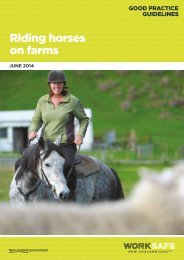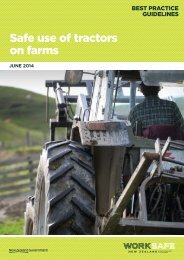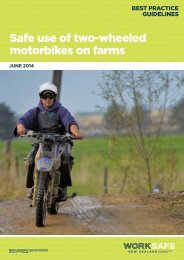PERFORMANCE
our-performance-story-2015
our-performance-story-2015
You also want an ePaper? Increase the reach of your titles
YUMPU automatically turns print PDFs into web optimized ePapers that Google loves.
OUR <strong>PERFORMANCE</strong> STORY 2015<br />
27<br />
Working smarter<br />
TAKING AN EVIDENCE-BASED<br />
APPROACH<br />
We are committed to building an evidence base<br />
to guide our work to deliver maximum benefit.<br />
In June 2015 we released Health and Safety<br />
Attitudes and Behaviours in the New Zealand<br />
Workforce: A survey of Workers and Employers.<br />
This significant multi-year survey will inform<br />
our work, help to monitor important elements<br />
of the health and safety system, and support<br />
our engagement activities in target sectors.<br />
In 2014/15 we improved our data, analysis, and<br />
understanding of New Zealand’s highest-risk<br />
sectors. The workplace injury data provided to<br />
us by ACC is an invaluable component of our data<br />
landscape, supporting our modelling work and<br />
our intervention planning. Our ability to take an<br />
evidence-based approach will improve as we build<br />
our new Research and Evaluation and Operational<br />
Intelligence teams and the systems supporting their<br />
work. These functions will strengthen our ability<br />
to determine baselines, define targets, and deliver<br />
a proactive approach to targeting risk.<br />
DUTY-HOLDER REVIEWS<br />
WHAT IS A DUTY-HOLDER?<br />
A duty-holder is a person with health and<br />
safety responsibilities under the law.<br />
A DHR is an investigation guided by us but<br />
undertaken by an employer after an incident has<br />
taken place at their workplace. DHRs help dutyholders<br />
to identify why an accident happened and<br />
how to prevent it happening again. The process is<br />
voluntary. Since its inception in November 2014 we<br />
have supported over 280 workplaces through the<br />
process. Our intention is that people in workplaces<br />
learn and make lasting improvements to their health<br />
and safety systems. It is not just about fixing the<br />
immediate problem, but also about addressing the<br />
cause of the problem and supporting positive health<br />
and safety changes across the whole business.<br />
A recent case: A night-shift worker lost the tip<br />
of his finger when it got caught between rollers<br />
in a printing press. The company informed us<br />
that they were very surprised because nothing<br />
like this had happened before, they have an<br />
active health and safety culture on site, and the<br />
operator had done the task often and without<br />
incident. In the duty-holder review, the company<br />
initially considered providing extra training<br />
and updating its procedures so that everyone<br />
knew how to operate the machine safely.<br />
The firm had initially ruled out the feasibility<br />
of putting a guard on the machine. Our DHR<br />
officer suggested contacting the manufacturer<br />
or supplier to check. A conversation with the<br />
supplier revealed that there had been ten<br />
similar accidents involving these machines in<br />
New Zealand and that guards could be installed<br />
to make them safer, even on old machines.<br />
The company then designed and installed<br />
appropriate guarding. As a result of undertaking<br />
a DHR the company was able to retrofit guarding<br />
and learn from the experience in a way that it<br />
might not otherwise have done.<br />
SEEING WRITTEN GUIDANCE<br />
AS PART OF OUR EDUCATION<br />
AND SUPPORT<br />
An important part of our work is providing good<br />
written guidance and presenting it in the best way<br />
for target audiences. These guidance documents<br />
form part of our educative approach. When







